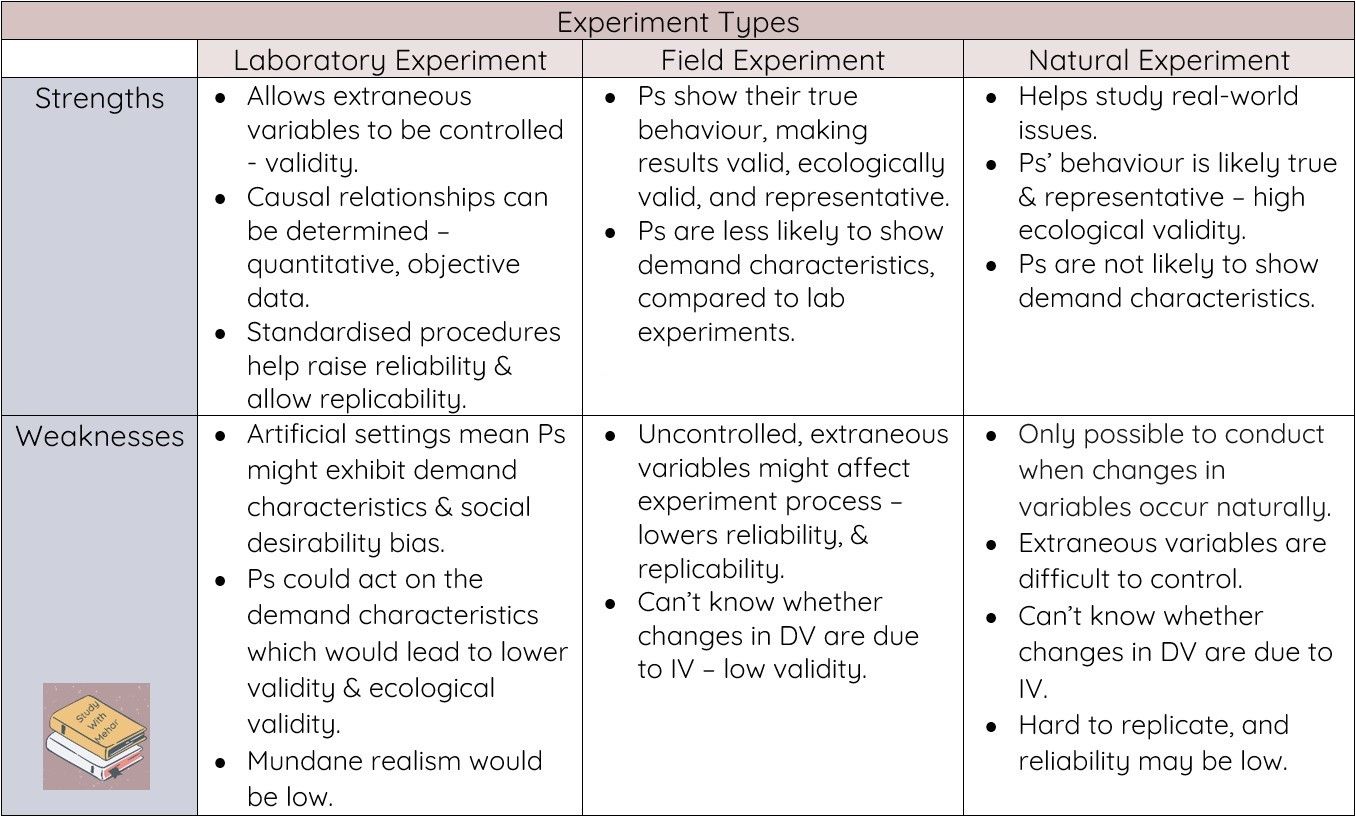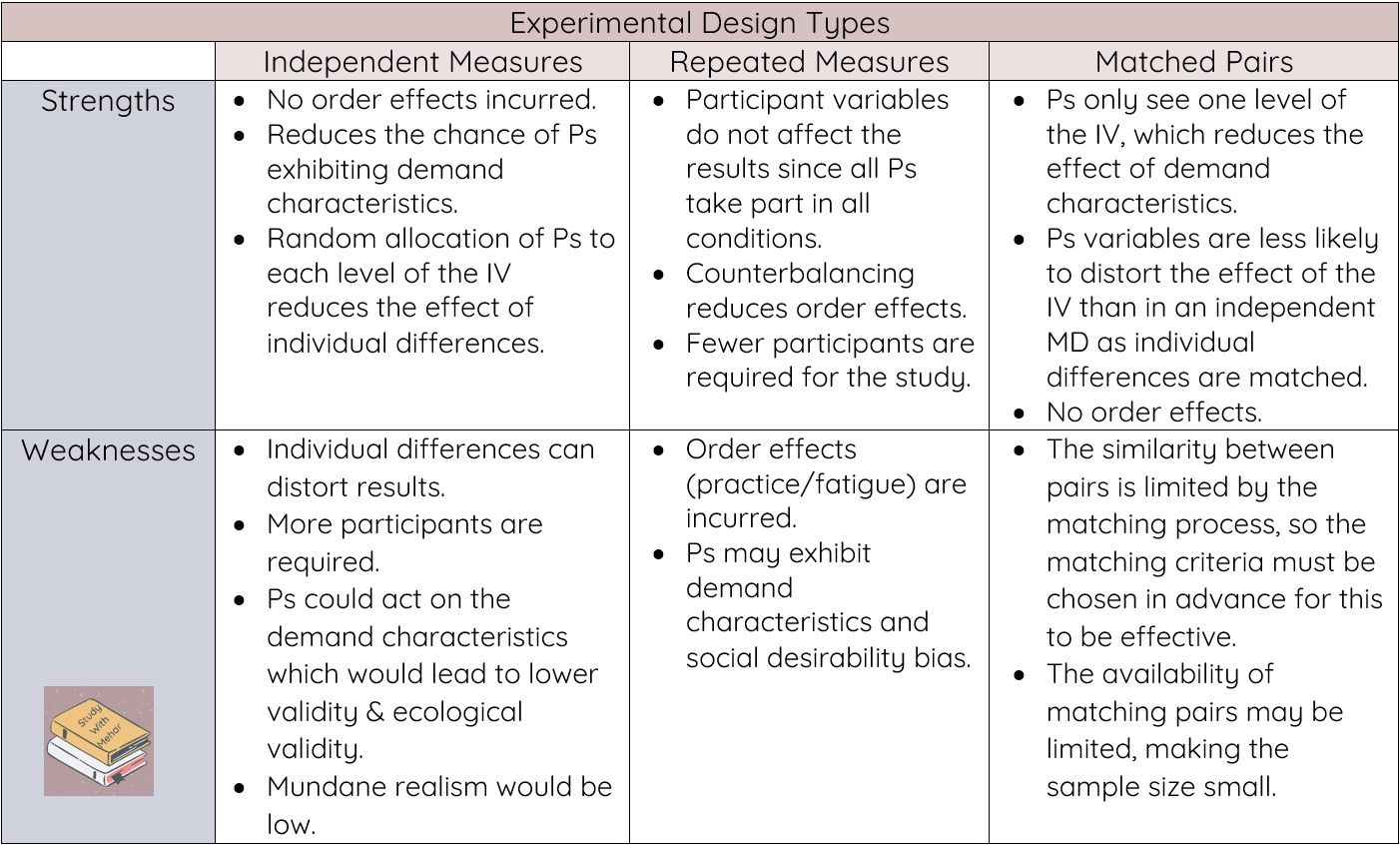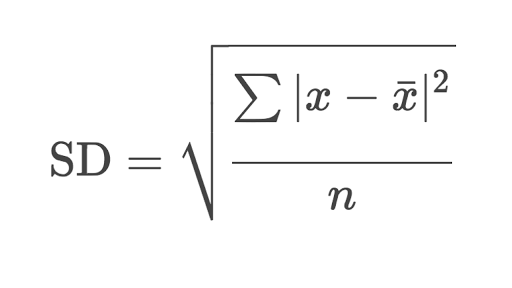Psychology Research Methods
Experiments, Self Reports, Case Studies, Observations, Correlations, Research Process, Variables, Sampling participants, Data & Data Analysis, Ethical Considerations, and Evaluating Research.
Topics:
- Experiments
- Self Reports and Case Studies
- Observations and Correlations
- Research Process
- Ethical Considerations
- Evaluating Research
Please note that I have abbreviated 'Participants' to 'Ps' throughout the website.
The Independent Variable (IV) is the variable that is manipulated by the researcher to check its effect on the dependent variable.
The Dependent Variable (DV) is the variable being measured by the researcher.
Research Methods
Experiments
Experiments look for a causal relationship in which an independent variable is manipulated to cause a change in the dependent variable.
Experiment types:
- Laboratory experiment – the experiment is conducted in an unnatural and controlled environment. The IV is manipulated by the researcher.
- Field experiment – the experiment takes place in natural settings, and the IV is manipulated by the researcher.
- Natural experiment – the experiment takes place in a natural setting and the IV is not directly manipulated by the researcher. It happens naturally by chance.
- Quasi-experiment – the researcher has lots of control over the procedure, but not over the allocation of participants.
Laboratory Experiments Evaluation
Strengths:
- Allows extraneous variables such as participant variables (individual differences) to be controlled. This helps raise validity.
- Causal relationships can be determined with the scientific data gathered (quantitative data) since lab experiments attempt to make studies as scientific as possible.
- Standardised procedures help raise reliability and allow replication.
Weaknesses:
- Since the experiment takes place in artificial settings, there are chances of participants exhibiting demand characteristics and social desirability bias.
- Participants could act on the demand characteristics as a response and alter their behaviour which would lead to lower validity and ecological validity.
- Furthermore, the mundane realism of any tasks involved in the lab exp. would be low. Mundane realism is the extent to which any tasks involved in a study represent real-world activities.
Field Experiments Evaluation
Strengths:
- Participants are in natural settings showing their natural behaviour, hence they are likely to show their true behaviour. This would make the results highly valid, ecologically valid, and representative.
- If participants are unaware that they are in a study, there is very less chance of participants exhibiting demand characteristics, in comparison to lab experiments.
Weaknesses:
- There are chances of uncontrolled, extraneous variables affecting the experiment process, which could lead to obscure results. This means the reliability and replicability of the research lowers since not all variables can be factored in again.
- The researcher will be less sure that changes in the DV are caused by changes in the IV, in comparison to lab experiments. This leads to lower validity.
- The participants are unaware that they are in a study, and this raises the ethical issues of privacy, confidentiality, and lack of consent.
Natural Experiments Evaluation
Strengths:
- Natural experiments help to study real-world issues.
- When participants are in natural settings, their behaviour is likely to be true, and representative. This means the ecological validity is high.
- As participants are unaware of their participation in the research, there are very less chances of demand characteristics affecting the experiment.
- They help researchers investigate variables which wouldn’t be practical or ethical to manipulate.
Weaknesses:
- Natural experiments are only possible to conduct when changes in variables occur naturally.
- Extraneous variables are often very difficult to control.
- As the researcher isn’t manipulating the IV, they will be less sure of the cause of changes in the DV, so a causal relationship cannot necessarily be established.
- They are hard to replicate as controls and standardization are hard to implement, so the reliability may be low.

Experimental Design: how participants are allocated to the conditions of the study.
Experimental Design types:
- Independent measures design – different groups of participants are used for each level of the IV.
- Repeated measures design – each participant takes part in every condition of the study.
- Matched Pairs Design – participants are matched in pairs according to a characteristic they have, that is similar.

How to reduce participant variables:
- Implement the repeated measures design.
- Random Allocation – Participants are randomly distributed to each level of the IV to reduce the effect of individual differences (which is a confounding variable) affecting the study’s results.
Order effects occur when participants take part in more than one condition of the study.
- Practice effect – due to familiarity or learning how to solve the task.
- Fatigue effect – Participants’ performance declines when participating for too long, due to boredom or tiredness.
Use counterbalancing to overcome the order effects from impacting the study’s results, when implementing the repeated measures design.
When implementing the repeated measures design in a study, there are chances of order effects impacting the study’s results. Therefore, counterbalancing can be used to reduce order effects.
Counterbalancing – When the order in which each group attends each level of the IV is the opposite. A,B. B,A.
How to improve generalisability: Use randomization to select the sample for the study.
Randomisation: when you choose your sample for the study randomly.
Self Reports
- Questionnaires – research method using written questions.
Question types:- Close-ended (pre-set answer choices, quantitative data)
Evaluation:- Easier to analyse than interviews as it isn’t affected by researcher bias when calculating results.
- Simple to summarise, and derive results, & conclusions from.
- Responses may be limited – low validity as they can’t explain the reason.
- Open-ended (qualitative data).
-
Evaluation:
- Produces in-depth and detailed responses.
- Difficult to quantify.
- There is a chance that researcher bias might affect the interpretation of results.
General Questionnaire Evaluations:
- Easy for participants to ignore questions – low generalisability.
- When 2 researchers interpret results there may be a lack of inter-rater reliability.
- Close-ended (pre-set answer choices, quantitative data)
- Interviews – research method using verbal questions asked directly.
Interview types:- Structured (fixed questions)
- unstructured (questions depend on the answer of the respondent)
- semi-structured (fixed and unwritten questions).
Case Studies are detailed investigations about a single person or a small group. The maximum amount of qualitative and quantitative data is gathered.
Strengths:
- The data collected is highly valid.
- The researcher builds rapport with the subject, making it likely for them to open up and provide true information.
- The subject is less likely to show demand characteristics as case studies are longitudinal studies.
Weaknesses:
- The researcher’s findings may be biased due to the close relation with the subject.
- The data is low in reliability and replicability.
- The data is only internally valid.
Observations
- Naturalistic observation: participants' behaviour is observed in their natural environment without it having any manipulations from the researcher.
- Controlled Observation: participants’ behaviour is observed in a setting that has been manipulated by the researcher (maybe in the participants’ natural environment).
- Unstructured: researcher records all of the behaviours being exhibited by the subject.
- Structured: researcher records only the particular behaviour being studied.
Correlations
A correlation is a statistical relationship that suggests the probability of a true relationship between the IV and DV of the study. A correlational relationship is not necessarily a causal relationship.
To make sure whether a correlational relationship is causal, the two variables must be investigated in a laboratory environment where extraneous variables are controlled.
Research Process
Hypothesis – a testable statement predicting the outcomes of a study.
- Non-directional hypotheses: predicts that there will be a relationship between the variables, but does not specify the direction of the relationship.
- Directional hypotheses: predicts that there will be a specific relationship between the variables.
- Null hypotheses: any relationship that is found between the variables is purely due to chance.
Variables
Operationalisation: defining variables to accurately manipulate, measure, quantify, and replicate.
Pilot studies are conducted to analyse the technical and financial risks and to assess the feasibility of the study. Any plausible confounding variables are found and controlled to ensure it does not affect the real trial.
Standardised procedures are important to ensure that all participants undergo the same procedure. This helps to increase reliability and replicability.
Sampling participants
- Opportunity sampling: participants are chosen because they are available.
Strengths – Quicker and easier than other methods.
Weakness – Likely to be non-representative, as people from the same area may be a biased sample. - Volunteer (self-selecting) sampling: participants are invited to participate. Those who reply will be part of the sample.
Strengths – participants are likely to stay committed and would be willing to return for repeated testing.
Weakness – The sample may be unrepresentative because people who respond may be similar (they may have free time). - Random sampling: all participants are chosen randomly. Could be with a draw, or random number generator.
Strengths – The sample is likely to be representative of the target population as all type of people has an equal chance of being chosen.
Weakness – Everyone may not be equally chosen. For example, there could be more girls chosen randomly than boys.
Data & Data Analysis
Quantitative Data: data in numerical format.
Strengths: objective measure, very reliable, data can be analysed using statistical methods and, data is easy to compare.
Weaknesses: limits responses of participants, so data may not be very valid.
Qualitative Data: data written in a non-numerical format that often expresses a quality or opinion.
Strengths: highly valid, unrequested, but important data is incurred.
Weaknesses: data interpretation may be subjective. Not representative, generalisable, or reliable.
Data can be analysed using the measure of central tendency such as the mode, median, and mean, and measures of spread such as the range, and standard deviation.
The measure of central tendency: a mathematical way to find the average score from a data set using the mode, median, and mean.
The measure of spread: a mathematical way to describe the variation within a data set.
Standard Deviation: the average difference between each score in the data set and the mean.

T-test: a statistical test used to determine any significant difference between the mean scores of 2 groups.
Graphs such as bar charts, histograms, scatter graphs, and normal distribution curves can be used to provide a visual illustration of the data.
Ethical Considerations
For human participants:
- Informed consent: The aim should be told to the participants before the study. If the aim needs to be hidden to protect the validity of the finding, then sufficient data about the study should be given to participants for them to decide whether they want to participate or not.
- Protection (physical and physiological)
- Right to withdraw: they should be informed that they can withdraw at any point.
- Deception: participants should not be deceived during the study however if it’s necessary to do so to protect the findings of the study, then participants need to be debriefed.
- Confidentiality: participants’ identities and personal data should be concealed from the general public.
- Privacy: Invasive/private questions should be avoided. Participants should be made aware of their right to ignore the questions they incur during the study.
- Debriefing
For animals:
- Replacement: try to use alternatives such as video recordings instead of animals.
- Species and strain: chosen species/strain should be least likely to suffer pain. Whether they were socially housed or participated in other studies.
- The number of animals: minimum no. of animals required should be used.
- Pain and distress: research causing any form of physical, emotional, or psychological harm should not be conducted.
- Housing: Isolation and crowding can cause animals distress. Caging conditions should depend on the social behaviour of the species. Overcrowding ➔ distress & aggression.
- Rewards, deprivation, and aversive stimuli: Normal drinking and feeding patterns of the animal should be followed. Preferred food should be used as a motivator, rather than deprivation.
- Anaesthesia, analgesia, and euthanasia: During surgery, anaesthesia and analgesia should be used. If the animal suffers lasting pain, it should be euthanised.
Evaluating Research
- Reliability – the consistency of the outcome.
- Validity – the extent to which the study measures what is intended to study.
- Ecological Validity – the extent to which the results of the study represent real-life behaviour.
- Generalisability – the extent to which the results represent the behaviour of the target population.
- Test-retest: a way to measure the consistency of a test. The test is used twice and if the scores on both tests are similar, then it has good reliability.
- Demand Characteristics – when participants change their behaviour as they derive cues on what is expected of them.
- Inter-rater reliability – the extent to which similar conclusions are produced by two researchers interpreting the same qualitative responses.
- Inter-observer reliability – the extent to which similar observations are produced by two researchers observing the same event.
